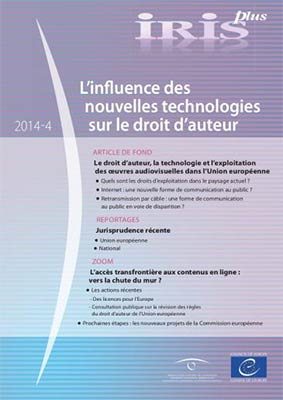The digital revolution has transformed our ways of accessing protected works. Online services, streaming, technology torrent and other digital means offering content pose many challenges to the current legislation on copyright. Indeed, it seems that regulators are still running after the latest technological developments when it comes to propose an appropriate regulatory structure. The European Audiovisual Observatory, part of the Council of Europe in Strasbourg, has just published a new IRIS plus report:
The influence of new technologies on copyright.
 The last overhaul of legislation of copyright in force dates back to 15 years. At the time, the InfoSoc Directive set rules regulating the public communication of protected content. The rules for the retransmission of content, determined by the SatCab directive, continue to apply and are unchanged since 1993. The Observatory will explore the current legislative situation and raises the question of the need for a major overhaul.
The last overhaul of legislation of copyright in force dates back to 15 years. At the time, the InfoSoc Directive set rules regulating the public communication of protected content. The rules for the retransmission of content, determined by the SatCab directive, continue to apply and are unchanged since 1993. The Observatory will explore the current legislative situation and raises the question of the need for a major overhaul.
The feature article of this new publication was written by Lucia Guibault and João Pedro Quintais of the Institute for Information Law (IViR), based in Amsterdam. The article begins by focusing on the criteria developed by the Court of Justice of the European Union (CJEU) to determine if there has been “ public communication ” or not, in accordance with of the InfoSoc Directive. These criteria are also used to determine the identity of “ user “, the definition of “ public ” and the concept of “ new audience “to which the retransmission is sent.
Guibault Quintais and then examine the application of these criteria to new content delivery methods such as live streaming broadcast of television programs, hyper -links to websites and distinguish between standard links, and embedded links transclusion, for example. In this context, the article examines the various technical restrictions, the subsequent availability of the content, contractual restrictions, access to unauthorized content and unfair competition.
Given the antiquity Directive Sat-Cab, the feature article also examines the current legal framework regulating cable retransmission and its impact on the beneficiaries and the various collecting societies. The authors focus on the recent decisions in the Netherlands and Norway concerning the notion of “ direct injection ” (or the fact that a digital cable transmission is considered a ” primary communication “and not as a secondary communication and thus is not subject to royalty payments).
The Reports section of this new publication includes short articles on recent developments for private copying and liability for infringement online. Cases of liability are also presented.
The Zoom section was written by two legal analysts of the Observatory, and Francisco Cabrera Blázquez Sophie Valais. This chapter focuses on cross-border access to online content and presents the latest initiatives at European level: the dialog “ Licences for Europe ” between stakeholders and public consultation on the revision of the rules of the European Union copyright matters, launched in 2013. Cabrera and Valais conclude on the announcements made by the newly elected Commission concerning future programs.
The influence of new technologies on copyright – time for a redesign of our legislation in Europe is ripe
This new publication can be purchased in our online store: www.obs.coe? .int / en / shop / irisplus / – / asset_publisher / k6BP / content / iris-plus-2014-4
No comments:
Post a Comment